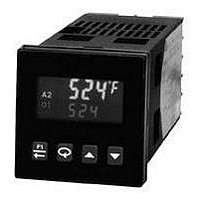T1610000 Red Lion Controls, T1610000 Datasheet - Page 22

T1610000
Manufacturer Part Number
T1610000
Description
Process/Temperature Controller
Manufacturer
Red Lion Controls
Type
Temperaturer
Specifications of T1610000
Operating Temperature Max
50°C
Operating Temperature Min
0°C
Output Voltage Max
250VAC
Controller Input
Thermocouple Or RTD
Supply Voltage Max
250VAC
Mounting Type
Panel Mount
Brand/series
T16 Series
Contact Form
SPST
Dimensions
49.5mmW×49.5mmH×115.3mmD
Enclosure Rating
IP65
Input Type
RTD/Thermocouple
Ip Rating
IP65
Memory
EEPROM
Output Type
Relay
Power, Rating
8 VA
Primary Type
Controller
Special Features
EEPROM
Standards
cURus, CE
Termination
Screw
Voltage, Supply
85 to 250 VAC
Thermocouple Type
J, K, T, E, R, S, B, N, C And Linear MV
Rohs Compliant
Yes
Lead Free Status / RoHS Status
Lead free / RoHS Compliant
TIME PROPORTIONAL PID CONTROL
On time using the Cycle Time. For example, with a four second cycle time and
75% power, the output will be on for three seconds (4 × 0.75) and off for
one second.
oscillation for the process. The natural period is the time it takes for one
complete oscillation when the process is in a continuously oscillating state.
LINEAR PID CONTROL
to % Output Power, OP. The Analog Low Scaling, ANLO , is set to 0.0 and the
Analog High Scaling, ANHI , is set to 100.0. The Analog Output will then be
proportional to the PID calculated % output power for Heat or Cooling per the
Control Action OPAC. For example, with 0 VDC to 10 VDC (scaled 0 to 100%)
and 75% power, the analog output will be 7.5 VDC.
AUTO-TUNE
automatically determine the Proportional Band, Integral Time, Derivative Time,
Digital Filter, Control Output Dampening Time, and Relative Gain (Heat/Cool)
values based upon the process characteristics. The Auto-Tune operation cycles
the controlling output(s) at a control point three-quarters of the distance
between the present process value and the setpoint. The nature of these
oscillations determines the settings for the controller’s parameters.
first tested. (This can be accomplished in On/Off Control or Manual Control
Mode.) If there is a wiring, system or controller problem, Auto-Tune may give
incorrect tuning or may never finish. Auto-Tune may be initiated at start-up,
from setpoint or at any other process point. However, ensure normal process
conditions (example: minimize unusual external load disturbances) as they will
have an effect on the PID calculations.
Start Auto-Tune
setting are acceptable then Auto-Tune can be started just by performing two
steps. If changes are needed, then they must be made before starting Auto-Tune.
1. Enter the Setpoint value in the Display Loop.
2. Initiate Auto-Tune by changing Auto-Tune Start tUNE to YES in the Hidden
Auto-Tune Progress
bottom display will flash the cycle phase number. Parameter viewing is
permitted during Auto-Tune. The time to complete the Auto-Tune cycles is
process dependent. The controller should automatically stop Auto-Tune and
store the calculated values when the four cycles are complete. If the controller
remains in Auto-Tune unusually long, there may be a process problem. Auto-
Tune may be stopped by entering NO in Auto-Tune Start tUNE.
P
In Time Proportional applications, the output power is converted into output
The cycle time should be no greater than 1/10 of the natural period of
In Linear PID Control applications, the Analog Output Assignment ANAS is set
Auto-Tune is a user-initiated function that allows the controller to
Prior to initiating Auto-Tune, it is important that the controller and system be
Below are the parameters and factory settings that affect Auto-Tune. If these
Loop.
The controller will oscillate the controlling output(s) for four cycles. The
ID
DISPLAY
tYpE
FLtr
CHYS
tcod
db-2
tUnE
T
UNING
Input Type
Digital Filtering
On/Off Control
Hysteresis
Auto-Tune Code
Deadband
Auto-Tune Access
PARAMETER
E
tc-
Curr
XPLANATIONS
FACTORY
[HidE]
SETTING
0. 2
2
[0]
[0]
1
T16
P16
P16
T16
MODULE
1-IN
1-IN
2-OP
2-OP
5-O2
3-LC
22
MANUAL CONTROL MODE
(does not use the setpoint and process feedback). The user adjusts the
percentage of power through the % Power display to control the power for
Output O1. When Alarm 2 is configured for Cooling (O2), Manual operation
provides 0 to 100% power to O1 (heating) and -100 to 0% power to O2
(Cooling). The Low and High Output Power limits are ignored when the
controller is in Manual.
MODE TRANSFER
controlling outputs remain constant, exercising true “bumpless” transfer. When
transferring from Manual to Automatic, the power initially remains steady, but
Integral Action corrects (if necessary) the closed loop power demand at a rate
proportional to the Integral Time.
AUTOMATIC CONTROL MODE
determined by PID or On/Off calculations based on the setpoint and process
feedback. For this reason, PID Control and On/Off Control always imply
Automatic Control Mode.
In Manual Control Mode, the controller operates as an open loop system
When transferring the controller mode between Automatic and Manual, the
In Automatic Control Mode, the percentage of output power is automatically
AUTO-TUNE CODE FIGURE
AUTO-TUNE OPERATION
(REVERSE ACTING)









